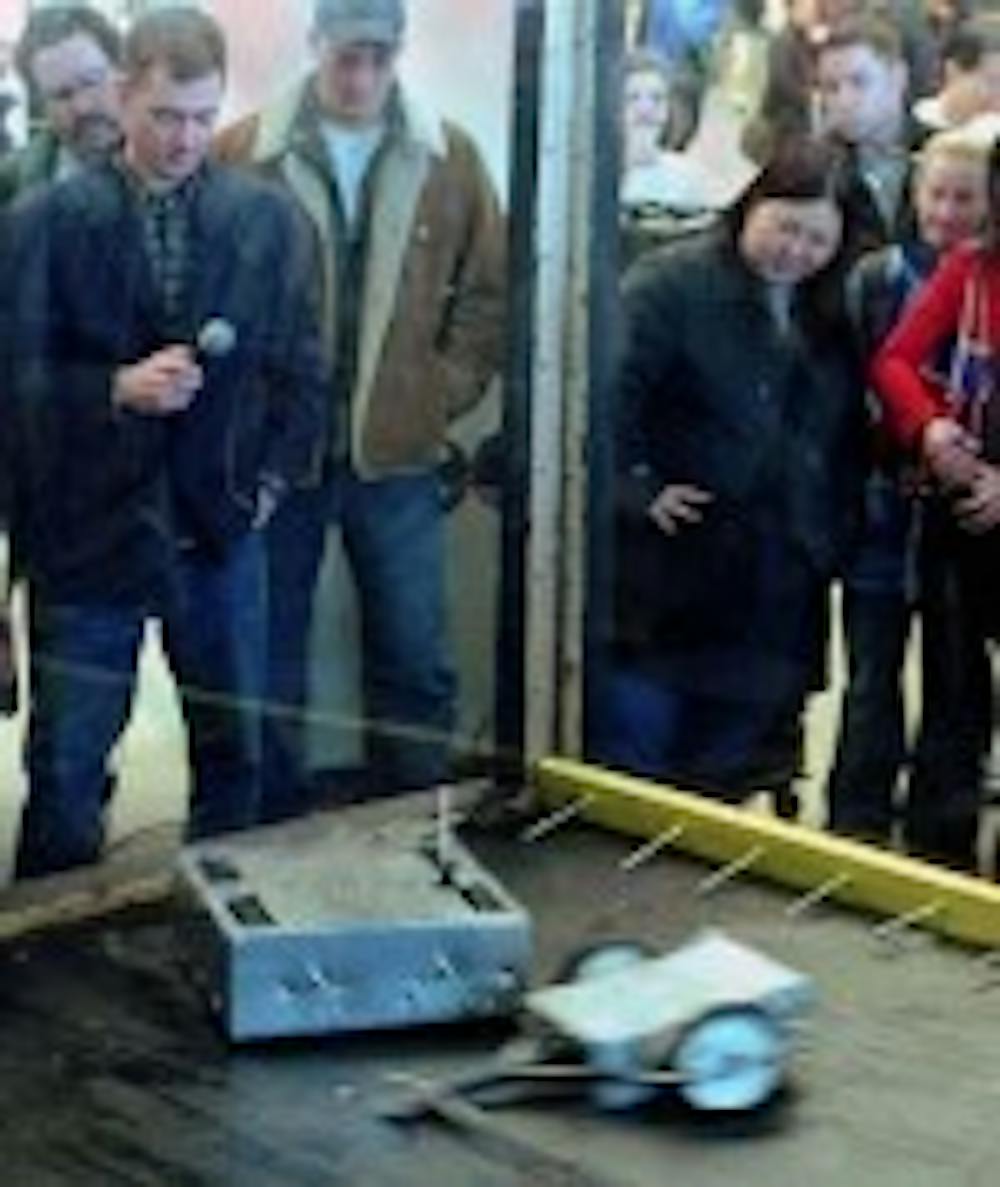Sounds of whirring blades and crashing metal filled the Student Union on Thursday as 10 student-designed robots squared off against one another in a fight to the scrapheap.
As part of Engineering Week, the Student Association Engineering Council and Clubs held its annual "UB Bot Wars" - modeled after Comedy Central's "Battlebots" - in which students design and build robots that compete to dismantle each other.
The Society of Automotive Engineers took top honors with a robot named "Drill Sergeant." The UB Robotics Club's robot, "George," was the runner-up.
Event Coordinator James Ambrose, a senior majoring in mechanical and aerospace engineering, served as the announcer and said UB Bot Wars surpassed his expectations.
"This event was very successful," Ambrose said. "Bigger, better, more competitive - we had 10 robots. The quality of them was very good."
During the last fight of the competition, all functioning robots were thrown together in the ring. George slammed the National Society of Black Engineers' robot, "Runaway Bot," into the sidewall with such great force, the wall momentarily detached.
The crowd roared when the robots smashed into the wall. The event, which lasted throughout the afternoon, drew throngs of people who stood and watched as the bots tried to tear each other apart.
"Every year we draw a crowd two, three (people) deep. This year was no exception," Ambrose said. "The robots were ready to go. Everything worked as they were supposed to."
Ambrose said this year's Bot Wars was more competitive than last year's, due to rule changes that were implemented.
This year's bots were allowed to weigh up to 30 pounds, while last year the robots could not exceed 25 pounds. The amount of money teams could spend on their robots also went from $200 to $400.
"It allowed more freedom for the engineers as far as weaponry went," Ambrose said. "It created a greater freedom to design."
Ambrose said the rules were changed because the former limits restricted performance ability.
"With fewer limitations, the robots could be more deadly," he said. "We're thinking of increasing the weight next year to 35 pounds."
Robert Sielaff, a junior majoring in mechanical engineering and a member of the winning team, said the competition benefited from the change in rules.
"The bots weren't too good last year, but this year, they were a lot more powerful," said Sielaff.
Drill Sergeant was an entirely different design from last year's machine. It was built around a pole, with two massive nails protruding from its sides. Drill Sergeant's plan of attack was to spin around and knock the other robots with its force.
Mike Miscione, a senior mechanical engineering major and member of the UB Robotics Club, described George as a "push robot."
"It has spikes on the front and back and just pushes everyone around," said Miscione.
Miscione's club entered two robots in the event, one of which was "Snail," last year's winner. By chance, Snail squared off against George in the semi-finals.
Mike Abbatte, a freshman engineering major on the UB Robotics team, predicted before the bout that George would be the victor, due to the fact that George and Snail were very similar, but Snail's pneumatic hammer had been destroyed in a previous match and could not move as fast as George.
Terik Gaines, a senior mechanical engineering major, and Christopher Regent, a freshman aerospace engineering major, both worked on Runaway Bot, by far the lightest robot in the competition. Runaway Bot zipped across the ring, hoping to ensnare opponents into the blades sticking out of the ring's floor.
"Our strategy was to run away and lure the opponent into the hazards," said Gaines.
The pair said Runaway Bot, which they described as a "scared bot," had less bravado than some of the larger robots.
The Society of Women Engineers' robot, "Wedgie: Not Your Average Melvin," was a wedge-shaped robot, which aimed to get under the other bot and push them around.
Sara Sieteski, a senior majoring in biomedical engineering, said the team lost due to the other robots' greater speed.
"Traditionally, the other robots have been slow; this is the first year they've been on par with us," she said.
However, Sieteski said her team's robot had one of the most innovative designs, which used the wiper blade motor from a Saturn as the robot's engine. Her team also created the robot's shell from an old computer case.
For onlookers, who stood in around the ring with wide eyes and jaws slightly opened, it may have been sheer fascination that kept them watching all afternoon.
"It's cool," said Shacoya Jackson, a freshman undecided major. "Things are in there hitting each other."





